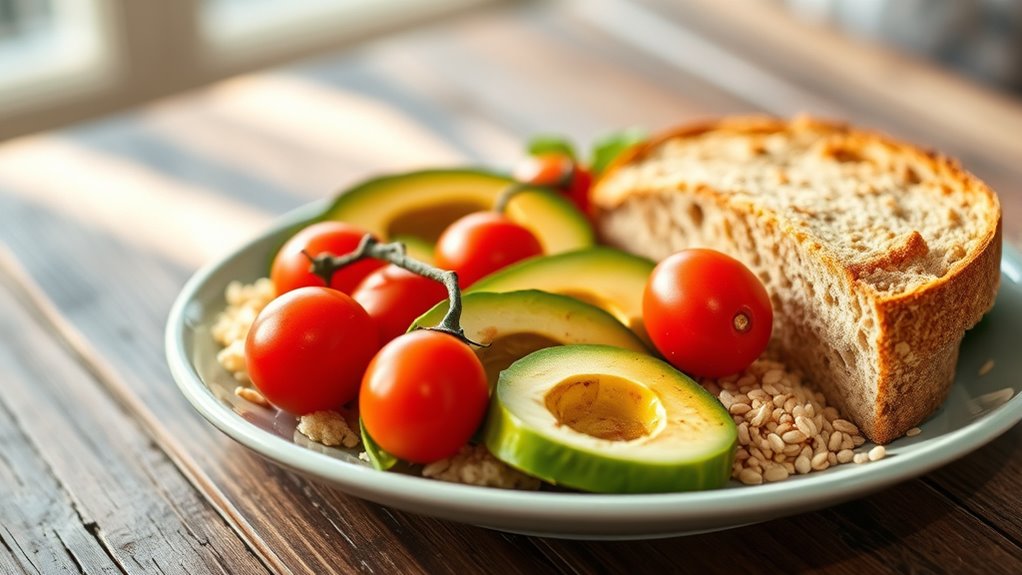Understanding the glycemic index (GI) helps you choose foods that keep your blood sugar steady and energy levels consistent. Low-GI foods like legumes, vegetables, and whole grains digest slowly, preventing spikes, while high-GI options cause quick blood sugar increases. How you prepare and ripeness also matter. By including fiber and protein with your meals, you can maintain better energy throughout the day. To learn smart ways to manage your blood sugar with GI, keep exploring these tips.
Key Takeaways
- The Glycemic Index measures how quickly carbohydrate foods raise blood sugar levels after eating.
- Low-GI foods (55 or less) provide steady, sustained energy, while high-GI foods (70 or more) cause quick blood sugar spikes.
- Combining low-GI foods with protein and fiber helps stabilize blood sugar and maintain consistent energy levels.
- Food preparation methods, ripeness, and processing significantly influence a food’s GI and its effect on energy.
- Choosing whole grains, legumes, vegetables, and fruits supports steady energy by promoting gradual carbohydrate absorption.
What Is the Glycemic Index and How Is It Calculated
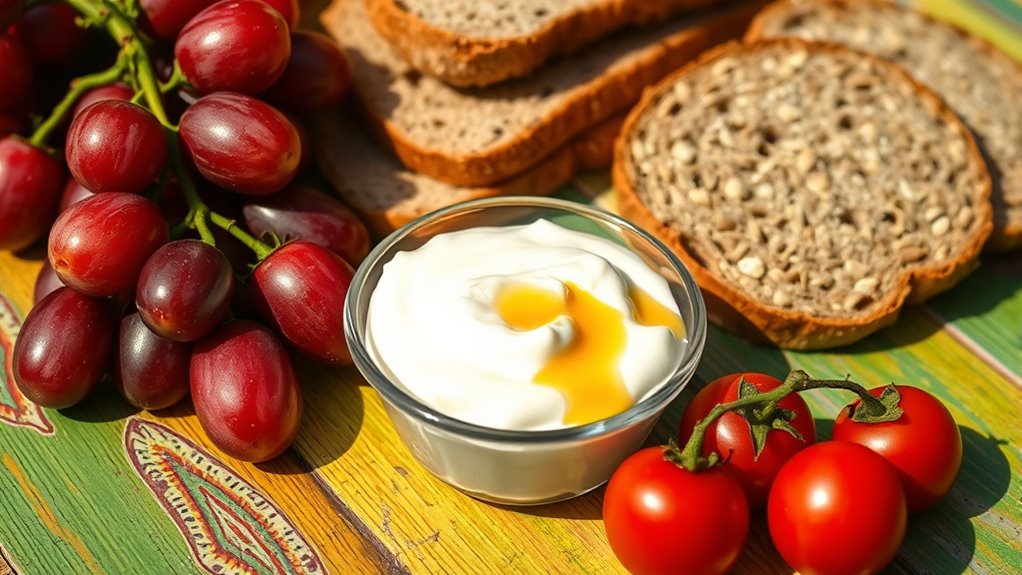
The glycemic index (GI) measures how quickly carbohydrate-containing foods raise your blood sugar levels after eating. It’s a way to understand how different foods impact your energy and insulin response. The GI ranks foods based on their carbohydrate classification, which includes simple and complex carbs. Simple carbs, like sugars, usually have a high GI because they digest rapidly, causing quick spikes in blood sugar. Complex carbs, found in whole grains and legumes, tend to have lower GI values since they digest more slowly, providing a steadier energy release. To calculate the GI, scientists compare the blood sugar response after eating a fixed amount of the test food to that after consuming a standard reference food, like glucose or white bread. This comparison helps you choose foods that promote stable blood sugar levels and sustained energy throughout the day. Additionally, understanding sustainable coffee practices can inspire better choices that support environmental and community health. Recognizing the digestive process can further enhance your understanding of how different foods influence blood sugar and energy levels. Being aware of the carbohydrate digestion process can also help you better interpret GI values and make informed dietary decisions.
The Difference Between Low, Medium, and High GI Foods

Ever wonder how different foods impact your blood sugar levels? Foods are classified as low, medium, or high GI based on how quickly they raise blood sugar. Low GI foods (55 or less) release energy slowly, thanks to fiber benefits and complex carbohydrate types. Medium GI foods (56-69) cause moderate increases, while high GI foods (70 or more) spike blood sugar quickly. To visualize this: glycemic response, which refers to how your body reacts to different carbohydrate sources, helps explain these variations. Recognizing glycemic index can help you make better dietary choices for sustained energy levels.
| GI Level | Impact on Blood Sugar | Typical Examples |
|---|---|---|
| Low GI | Slow, steady energy | Legumes, whole grains |
| Medium GI | Moderate rise | Some fruits, whole wheat |
| High GI | Fast spike | White bread, sugary snacks |
Choosing more low GI foods helps maintain energy and supports balanced blood sugar levels.
Examples of Foods With Varying Glycemic Index Values
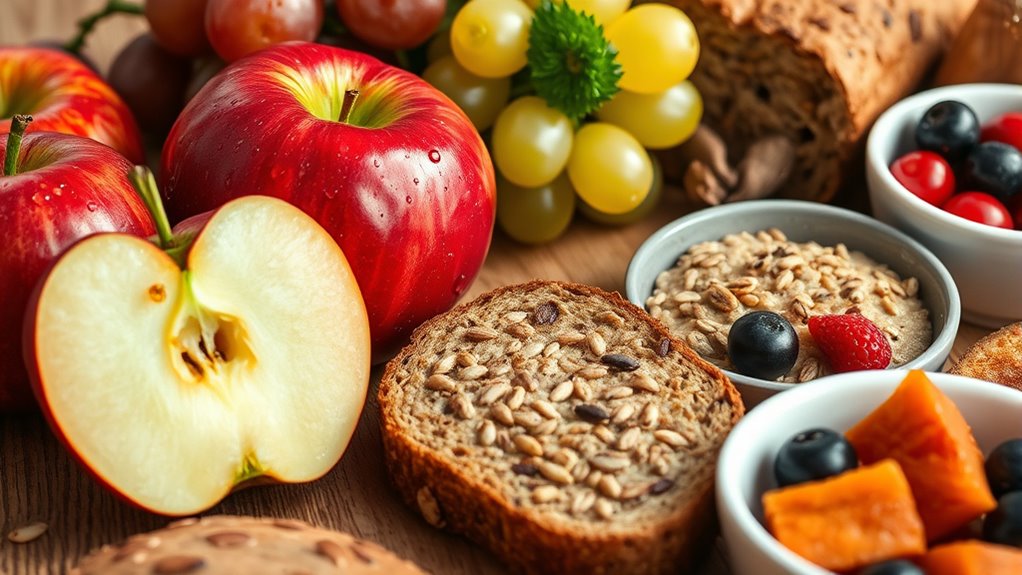
Are you curious about which everyday foods fall into different glycemic index categories? You’ll find that fruit varieties and grain differences markedly affect their GI values. For example, some foods have a low GI, providing steady energy, while others spike your blood sugar.
Consider these examples:
- Low GI fruits: cherries, apples, oranges
- Medium GI grains: brown rice, whole wheat bread
- High GI foods: watermelon, white bread, instant rice
- Fruit varieties: berries tend to have lower GI than bananas or pineapples
- Grain differences: refined grains like white bread have higher GI than whole grains
Additionally, understanding the glycemic index can help you make informed food choices to maintain energy levels throughout the day. Recognizing the personality traits associated with food choices can also support healthier eating habits. Incorporating home decor ideas into your kitchen or dining space can create a more inviting environment for mindful eating. Staying aware of how technology advances in food processing affect GI values can further refine your dietary decisions.
Why Your Blood Sugar Response Matters for Energy Levels
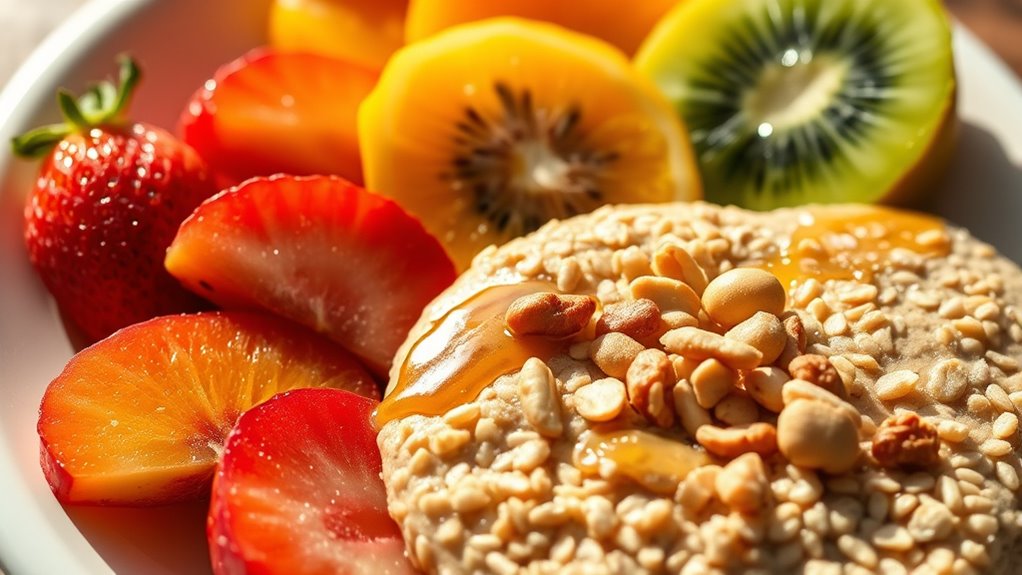
Your blood sugar response directly impacts your energy levels throughout the day. When your blood sugar fluctuates wildly, you may feel tired or irritable. Maintaining stable blood sugar helps you stay energized and focused. Understanding glycemic index can help you make better food choices to support steady energy. Being aware of tuning your diet can also aid in managing blood sugar fluctuations more effectively. Incorporating knowledge of blood sugar regulation techniques can further enhance your energy management strategies. Recognizing how dog breeds with different traits respond to dietary changes can also be beneficial in tailoring your nutrition plan for optimal energy.
Blood Sugar Fluctuations
Blood sugar fluctuations play a crucial role in how energized or sluggish you feel throughout the day. When your blood sugar spikes, your body responds with an insulin response to lower it. If this process isn’t well-regulated, you might experience energy crashes or cravings. Stable blood sugar levels support consistent energy, preventing rollercoaster effects. To manage this, focus on:
- Choosing low glycemic foods
- Balancing carbs with fiber and protein
- Avoiding processed sugars
- Eating regular, small meals
- Staying hydrated
Good blood sugar regulation helps your body use energy efficiently and keeps you alert. Recognizing how your blood sugar responds helps you make smarter food choices, reducing sudden dips and peaks. Monitoring your blood sugar response can help you identify which foods cause fluctuations and improve your overall energy stability. Being aware of blood sugar regulation mechanisms can enhance your ability to maintain steady energy levels throughout your day. Understanding how AI security vulnerabilities can impact data integrity is also essential for safeguarding your health information. This awareness is key to maintaining steady energy throughout your day.
Energy Stability Factors
Since fluctuations in blood sugar directly influence your energy levels, managing how your body responds to food is essential for staying alert and focused. Your blood sugar levels impact your energy balance, determining if you feel energized or sluggish. To maintain stability, consider how different foods affect your blood sugar response. Foods with a low glycemic index release sugar gradually, supporting steady energy. Conversely, high-GI foods cause spikes and crashes. Here’s a quick overview:
| Food Type | Effect on Blood Sugar | Impact on Energy |
|---|---|---|
| Whole grains | Stable release | Sustained energy |
| Sugary snacks | Rapid spike | Energy crash |
| Lean proteins | Moderate impact | Long-lasting power |
| Vegetables | Minimal effect | Consistent energy |
Focus on balancing your meals to support ideal energy stability.
The Impact of Food Preparation and Ripeness on GI
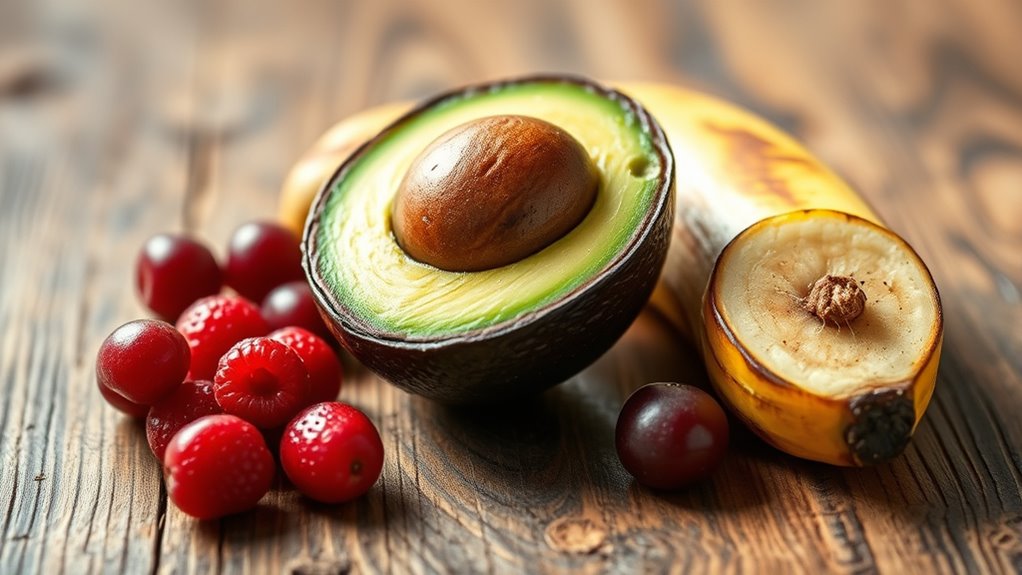
The way you prepare and ripen foods can considerably influence their glycemic index. As food ripeness increases, carbs become more accessible, often raising the GI. Cooking methods also play a role: boiling, for example, tends to produce a higher GI than steaming or baking. You can lower GI by choosing less ripe produce or using specific cooking techniques. Additionally, food ripeness principles highlight the importance of continuous monitoring and adaptive methods to effectively manage variables that influence GI levels. Proper food processing techniques can further help in controlling the GI, making some foods safer options for steady energy. Understanding how food preparation methods impact carbohydrate availability can help in selecting the best techniques to maintain stable blood sugar levels.
How to Incorporate Low-GI Foods Into Your Diet
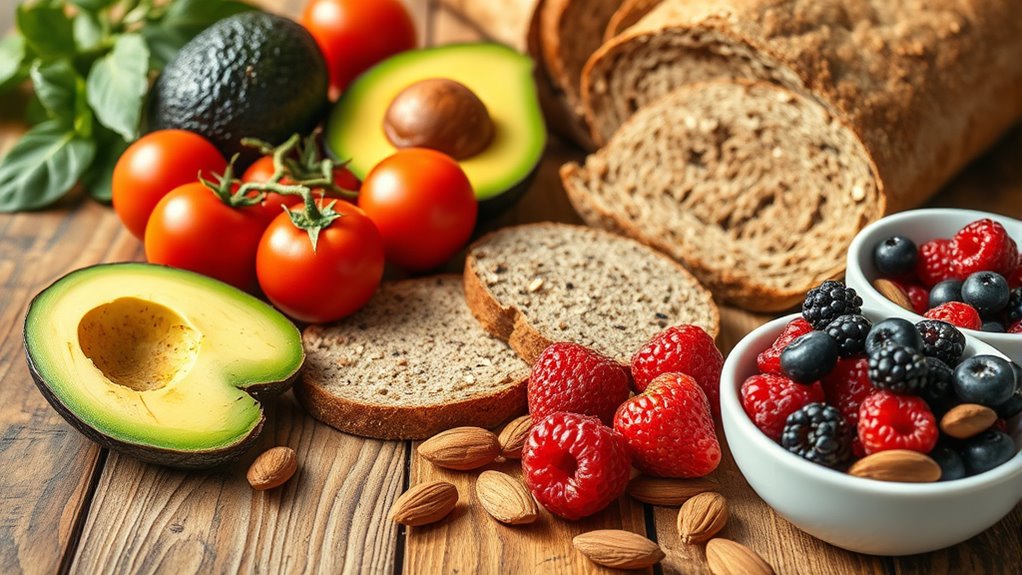
To incorporate low-GI foods into your diet, start by choosing whole, unprocessed options like vegetables, whole grains, and legumes. Pair these with protein and healthy fats to keep your blood sugar steady. Planning balanced meals helps you enjoy the benefits of low-GI eating without feeling deprived. Using quality kitchen tools such as a flat iron bike can make preparing healthy meals easier and more efficient. Incorporating self watering plant pots into your home can also encourage a more mindful, nourishing environment that supports your overall well-being.
Choose Whole, Unprocessed Foods
Opting for whole, unprocessed foods is one of the simplest ways to include more low-GI options in your diet. Whole foods like fresh fruits, vegetables, and unprocessed grains help maintain steady energy levels. They’re minimally altered, preserving natural fiber and nutrients that slow digestion and prevent blood sugar spikes. To incorporate more low-GI options, try these tips:
- Choose whole grains such as oats, quinoa, and brown rice
- Snack on fresh fruits instead of sugary processed snacks
- Swap refined bread for whole-grain or sprouted bread
- Incorporate legumes like lentils and chickpeas
- Opt for minimally processed, natural foods whenever possible
Combine With Protein & Fats
Incorporating low-GI foods into your meals becomes more effective when you pair them with protein and healthy fats. Protein pairing helps slow digestion and stabilizes blood sugar levels, preventing spikes after meals. Including a source of lean protein, like chicken, fish, or beans, enhances the meal’s satiety and keeps your energy steady. Fat inclusion also plays an essential role; healthy fats from nuts, seeds, or avocados further slow carbohydrate absorption. Combining these elements not only boosts the nutritional value but also makes your meals more satisfying. This strategic pairing supports sustained energy and reduces cravings. Remember, simple adjustments like adding a handful of nuts or a slice of cheese can make a significant difference in managing your glycemic response. Recognizing the emotional impact of dietary choices can also motivate healthier habits and support overall well-being.
Plan Balanced Meals
Creating balanced meals that include low-GI foods starts with thoughtful planning. Focus on meal timing to spread out carbohydrate intake evenly throughout the day, maintaining steady energy levels. Incorporate hydration strategies by drinking water or herbal teas to support digestion and reduce cravings. When planning, try to combine low-GI carbs with lean proteins and healthy fats to stabilize blood sugar. Keep these tips in mind:
- Pair low-GI grains with vegetables and proteins
- Eat smaller, more frequent meals
- Include fiber-rich foods for longer-lasting energy
- Stay hydrated between meals
- Avoid high-sugar snacks that spike blood sugar
The Role of Fiber and Protein in Modulating Glycemic Response

Fiber and protein play essential roles in moderating the body’s glycemic response after a meal. Fiber benefits include slowing digestion, which helps prevent rapid blood sugar spikes. Soluble fiber, in particular, forms a gel-like substance that delays carbohydrate absorption. Protein effects are equally important; consuming protein with carbs can reduce the overall glycemic response by stimulating hormones that slow stomach emptying. Including fiber-rich foods like vegetables, whole grains, and legumes, along with lean protein sources such as fish, poultry, or plant-based options, can help maintain steady energy levels. These dietary choices work together to stabilize blood sugar, improve satiety, and support overall health. By understanding fiber benefits and protein effects, you can better control post-meal glucose levels and promote sustained energy throughout the day.
Common Myths About the Glycemic Index
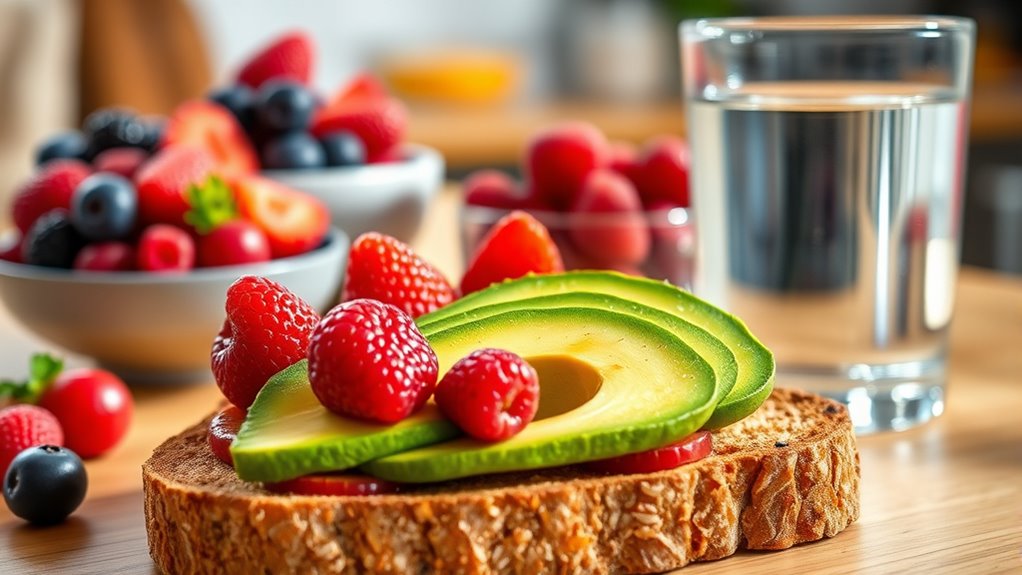
Many people believe that the glycemic index (GI) provides a complete picture of how foods affect blood sugar, but this is a common misconception. Myth busting reveals that GI alone doesn’t account for portion size, meal composition, or individual responses. To clear up some common misconceptions:
Many believe GI tells the full story, but it’s just one piece of understanding blood sugar impact.
- A low GI food is always healthier than a high GI one
- GI applies equally to all people and situations
- Combining foods can’t change the overall glycemic impact
- All carbohydrate-rich foods have high GI values
- The GI of foods remains constant regardless of ripeness or cooking method
Understanding these myths helps you make smarter choices. The GI is a useful tool, but it’s just one piece of the puzzle in managing blood sugar and maintaining steady energy.
Tips for Making Smarter Food Choices for Consistent Energy

To maintain steady energy levels throughout the day, you need to make smarter food choices by focusing on nutrient-dense, balanced meals. Pay attention to meal timing; eating at regular intervals helps keep your blood sugar stable and prevents energy crashes. Incorporate fiber-rich foods, lean proteins, and healthy fats to slow digestion and sustain energy longer. When choosing snacks, opt for options like nuts, fruit, or yogurt instead of sugary treats, which can cause spikes and drops in blood sugar. Planning your meals and snacks ahead of time ensures you avoid impulsive decisions that lead to energy dips. By making mindful choices, adjusting your meal timing, and selecting balanced snacks, you support consistent energy levels throughout your day.
Frequently Asked Questions
Can GI Values Predict Long-Term Health Outcomes?
GI values alone can’t predict long-term health outcomes, as they have limitations. While a low GI can help manage blood sugar and support better health, other factors like overall diet, activity level, and genetics play vital roles. You should consider GI as part of a broader approach rather than a sole predictor for long-term health predictions. Relying only on GI may oversimplify complex health relationships.
How Does the Glycemic Index Vary Across Different Populations?
You’ll find the glycemic index varies across populations due to cultural dietary patterns and genetic influences. For example, diets rich in high-GI foods like rice in Asian countries differ from those in Western nations that consume more bread and processed carbs. Genetic differences also affect how your body processes carbs, impacting GI values. Recognizing these variations helps you tailor your diet for better energy management and overall health.
Are There Any Risks Associated With Focusing Solely on Low-Gi Foods?
Focusing only on low-GI foods might seem healthy, but it can pose risks like nutrient deficiencies if you overlook other important nutrients. You could also face challenges with dietary restrictions, limiting variety and causing imbalance. It’s important to balance low-GI choices with nutrient-rich foods to guarantee you get essential vitamins and minerals, avoiding deficiencies and supporting overall health. Always consider a diverse diet rather than just low-GI options alone.
How Does Combining Foods Affect Overall Glycemic Response?
When you combine foods, your overall glycemic response can change because food pairing and meal timing influence how quickly carbs are absorbed. Including protein, healthy fats, or fiber slows digestion, preventing spikes in blood sugar. You can eat higher-GI foods with low-GI ones to balance effects. Paying attention to meal timing and combining foods thoughtfully helps maintain steady energy levels and avoids sudden sugar crashes.
Is There a Standardized Way to Measure GI at Home?
You might wonder if there’s a way to measure glycemic index at home. While home testing kits exist, their measurement accuracy is often limited compared to lab results. These kits usually involve monitoring blood sugar levels after eating specific foods, but they don’t provide a standardized GI value. For precise insights, professional testing remains the most reliable, helping you better understand how foods impact your blood sugar.
Conclusion
So, now that you’re a glycemic index guru, go ahead—indulge in that sweet potato or whole-grain toast. Just remember, it’s all about keeping your blood sugar from turning into a rollercoaster ride. Because nothing says “steady energy” like mastering the art of food choices without turning your day into chaos. Stay savvy, stay balanced, and enjoy the ride—your stomach and energy levels will thank you.

